The self-taught California artist’s roots in the Hollywood film industry inform her mysterious paintings, which confront grief, memory and ecological ruin. Now, as she enters her eighties, the artworld is finally taking note
Four years ago, when I first saw Jessie Homer French’s faux-naif narrative paintings in a mini-retrospective at Dublin gallery Mother’s Tankstation, the West Coast-based artist – then in her late seventies – was a relative unknown, although same-generation Angelenos like Ed Ruscha and Billy Al Bengston were friends of hers and admirers of her work. By last year, though, seven of her canvases were hanging in the overwhelmingly female international exhibition of the Venice Biennale. They included a CinemaScope-dimensioned image of advanced warplanes flying over a Mojave Desert windfarm (Mojave Stealth Bombers, 2013), an apparent depiction of a West Coast wildfire (Burning, 2020) and an oil rig in flames (Oil Platform Fire, 2019). So far, told thusly, the storyline conforms to a recent template: the older woman artist finally recognised by the sexist artworld, including, increasingly, the fancier end of the commercial scene. (After being latterly nurtured by smaller spaces, also including Los Angeles venue Various Small Fires – appropriately named after an artist book by Ruscha – Homer French recently showed at Massimo De Carlo’s Milan gallery.) We’ve seen this movie, or something like it. In other regards, though, her story is like that of no one else.
For starters, as her paintings’ frequently wide-aspect ratios might hint at, Homer French lived for many years predominantly in the American film industry. Her husband and de facto manager, Robin French, was a talent agent who handled Marlon Brando, among others, and from the late-1970s he was chief of production at Paramount – he and the New York-born Homer French met in 1969, by which time she had done swimsuit modelling as well as starting to paint, and they honeymooned a month later on the estate of Elizabeth Taylor and Richard Burton. French had a decagonal studio built for her in their Beverly Hills manse; she painted daily and in 1976 began a local exhibiting career (she still describes herself as a ‘regional’ painter), but also had four children. All of which, from a distance, might seem like the starting point for a vintage Joan Didion or Gavin Lambert novel, and thus might condemn Homer French’s artworks upfront as nothing more than the hobbyist diversions of a pampered Hollywood wife. But then you see the paintings, with their complicated amalgamating of the heartfelt and mysterious, the open and oblique, and their now-useful – because it makes the work look unusual and fresh – disregard of what the mainstream artworld might have thought contemporary art should be ‘about’. And you also may note, despite the work’s sociability and outward charm, that her overarching subjects are death and destruction.

Funeral (1978), which she began painting after her first daughter died, aged six, of complications from cerebral palsy, feels at first almost as if seen from the child’s own perspective: a dozen hunched, formally attired figures and a distribution of grey gravestones, some with fresh bouquets, dot a patch of greensward. A priest officiates by a flower-covered mound that feels to burst, contrarily, with life and liveliness, and you notice that while some of the mourners are dressed in customary black, others are in sunny white. The artist, you’d surmise from these commingled feelings, has done some coming to terms with death and its circular relationship to life, to things ongoing. Meanwhile, the image has a frontality suggestive of Henri Rousseau and American folk artists like Grandma Moses or Vestie Davis, and an even distribution of pictorial event, but also something of the sophisticated, rhythmic convening of figuration and abstraction you’d expect from Alex Katz, all wrapped around a presumptive core of understated, filtered heartbreak.

This would not be the last funeral scene that Homer French would paint, just as – inevitably – it would not be the last funeral she attended. Robin French died in 2021, and a painting from the following year, The Deepest Grave, depicts a green hillock topped by trees and a stone statue of the Virgin Mary; below are five mourners standing around a pile of brown earth, and then the underground is cross sectioned, with a deep black shaft ending in a laid-out older male figure, dressed in celebrant white to mirror the statue, about to reunite with the soil. In another recent cemetery scene presented the same way, City at Rest (2022), 17 figures of varying sizes and ages are visible beneath the ground; in Memento Mori (2022) there are 28 (in the background, more Stealth Bombers and a pair of smokestacks). The transparency of the formatting is reminiscent, again, of children’s perspectives, of books that show young minds how things work. This, Homer French suggests, speaking from experience, is how things work in terms of death, memory, honouring. And painting – she’s become, it appears, increasingly prolific since her husband passed – is perhaps a way through it all.
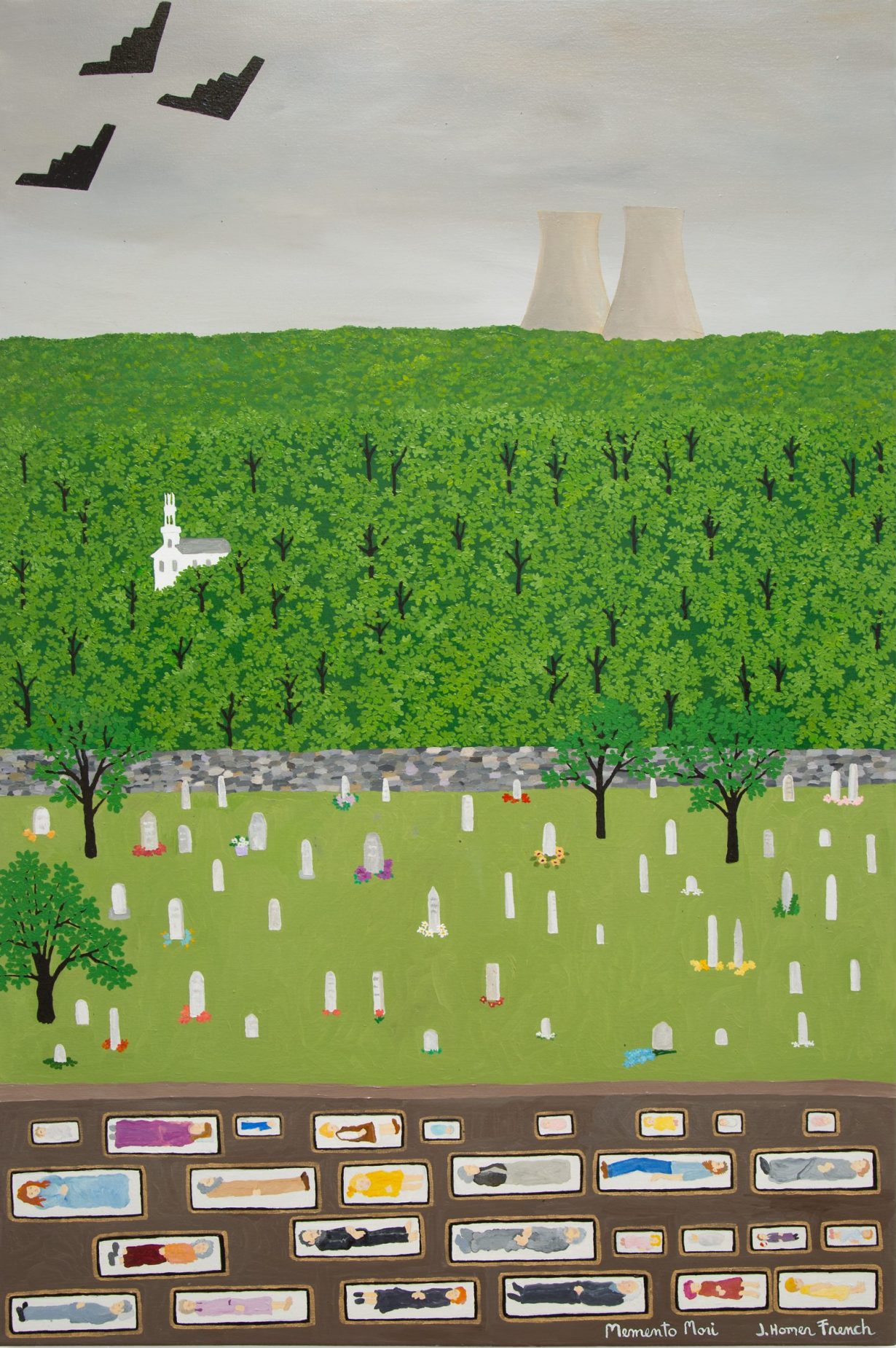

She frequently uses the same format when painting the natural world, as a way of making things visible. Homer French, who now lives in the Coachella Valley near Palm Desert, has been fanatical about fly-fishing since the 1970s, and in Twin Lakes, Bridgeport (2022), contextually huge fish sport temptingly beneath the waterline, as if the artist were a cave painter magicking her prey into existence by picturing it, and the composition rises to a serene mountain-range under blue skies. If Homer French just made marine paintings like this, they might scan as pleasurable but shallow, but such tranquil moments are counterweighted by, say, Tilapia Dieoff in the Salton Sea (2022), whose asymmetric semiabstract composition – clustered whitish fish corpses in brown water, dense at left and thinning to the right – recalls some of Monet’s Water Lilies, but is underscored by (perhaps) environmentalist concerns; real-world die-offs of the fish have been linked to lowered oxygen content in waters due to unstable temperatures and pollution.
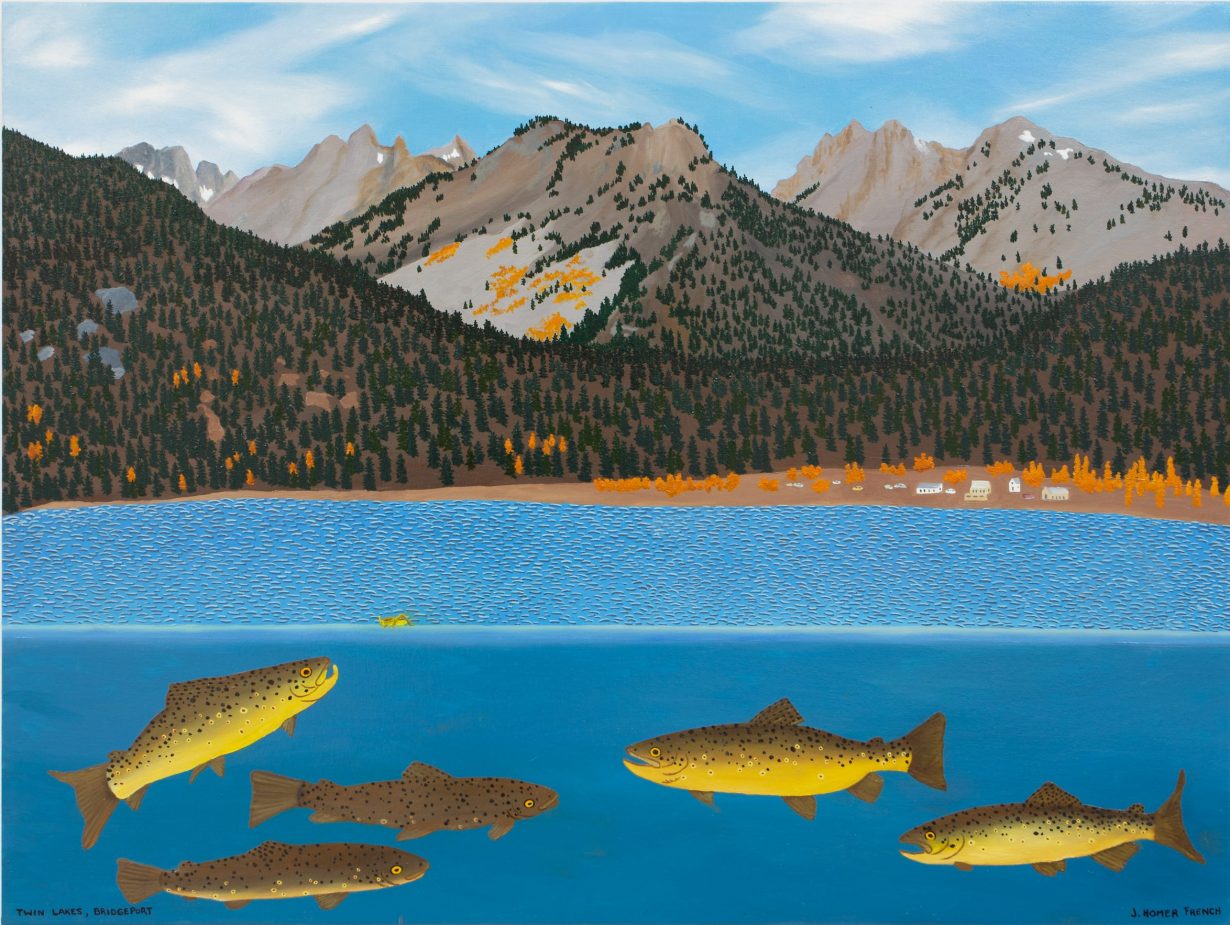
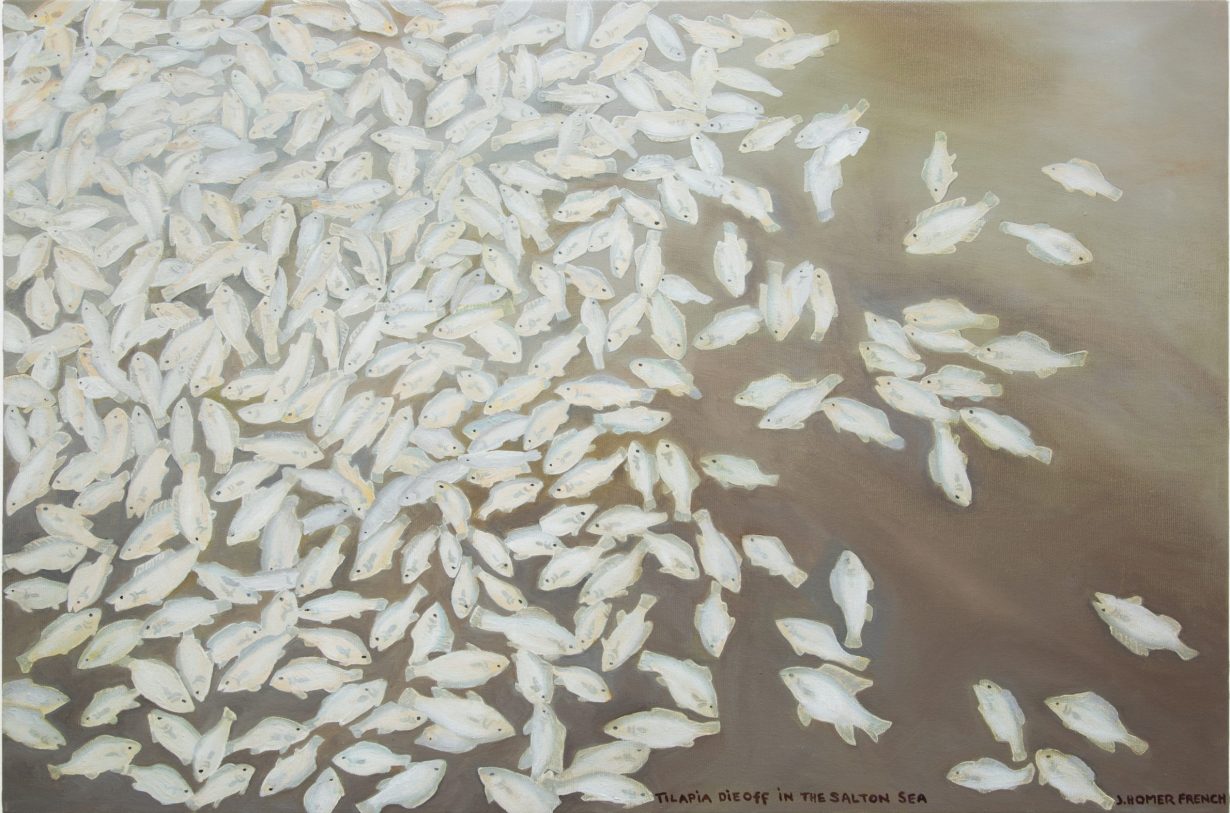
‘I don’t like heavy-handed political stuff; I come at it sideways’, Homer French said in a recent interview with Los Angeles Magazine. Her 2021 painting 97413 Blue River, Oregon depicts a rural post office surrounded by conifers and fronted by fish-filled freshwater. But she began painting post offices across America after Donald Trump started defunding the postal service to undermine postal voting, and this one has also burned down. Nun’s Honey (2021) features a nun beekeeper collecting honey; needless to say, there are ecological dimensions to keeping bees too (and Homer French has been buying the nun’s produce). Another painting, from 2018 and depicting wolves and deer in a wintry wonderland, initially looks bucolic and Brueghelian; but then you notice snowbound radiation-warning signs scattered about and clock the work’s title, in neatly handwritten caps at lower left: Winter Eden, Chernobyl.
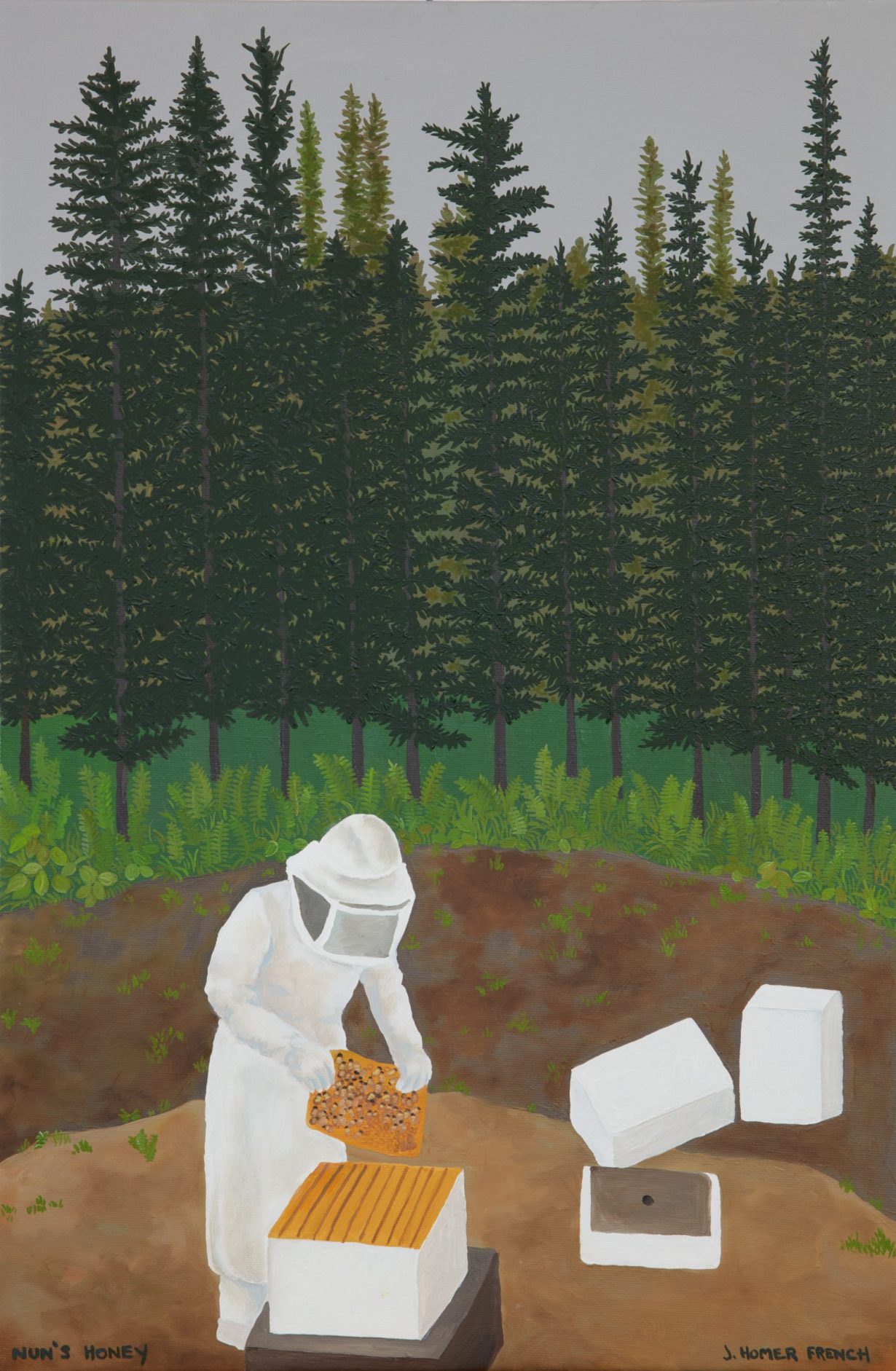
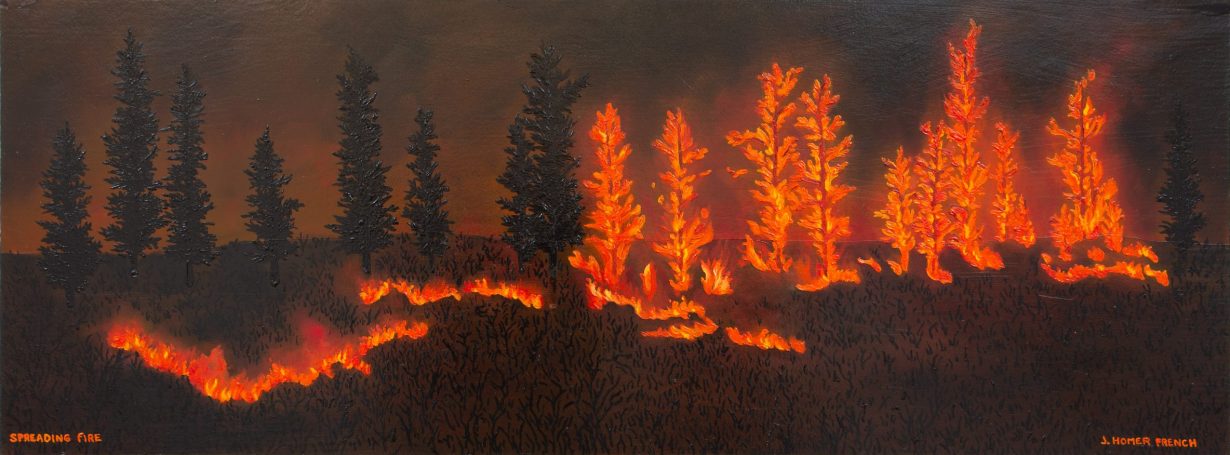
And then there are the many paintings that Homer French has made of fire, a recent example being the smoke-filled Spreading Fire (2022), in which 50 percent of a stand of conifers is aflame and the ground is too. Wildfires caused by global heating are a fact of life in the artist’s part of the world, and they might be said to microcosm our altered climate. But it’s notable that Homer French first started painting fires after witnessing a controlled burn, an act that can be environmentally renewing as well as destructive; as so often, her work points towards something about man’s interventions in nature but complicates it, sidesteps rhetoric and particularly resists hopelessness, sees bombers but also windfarms. There’s grief bunkered down in her art, but also a recognition that in so many ways, for better and for worse, death is inextricable from life. If that fact can’t be wished away, it might at least be faced with the equanimity – which shouldn’t be mistaken for naivety – that suffuses Jessie Homer French’s art. In the controlled burn, one might say, she’s found the perfect analogy for her practice.
